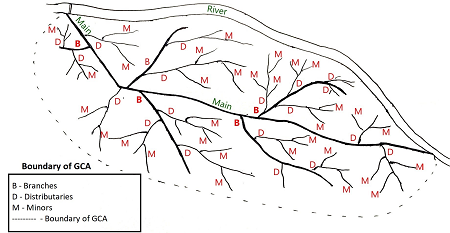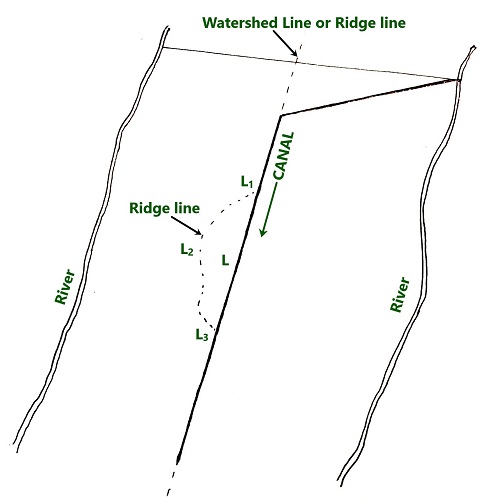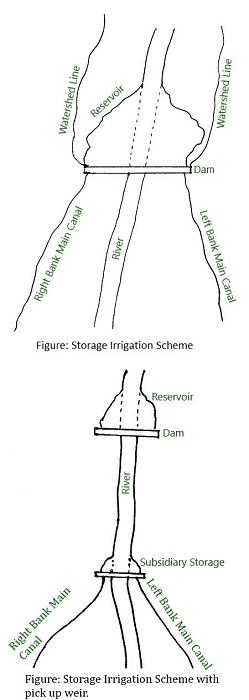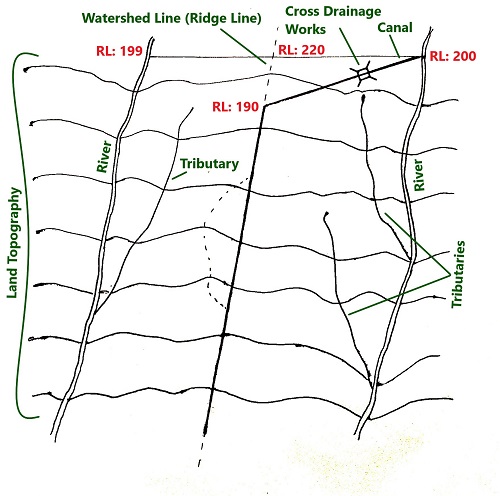Canal
A canal is an artificial channel, constructed on the land to carry water from rivers or any water source (tanks, dams, lakes, etc.) to the fields for various purposes like irrigation, power generation, navigation, etc.Generally, the canal has a trapezoidal shape and the main purpose behind building a canal is irrigation.
Based on the purpose of a canal, a canal can be categorised into the following types:
- Irrigation Canal
- Power or Hydel canal
- Navigation canal
Irrigation Canal
The canal that carries water for agricultural purposes is called an irrigation canal.
Example: Ganga canal, Indra Gandhi canal, Narmada canal, etc.
Power canal or Hydel canal
The canal that carries water to the power station for generation of electricity is called power or hydel canal.
Example: Nangal hydel canal
Navigation canal
The canal which is constructed for the purpose of navigation facilities is called navigation canal. These canals are built for saving time and fuel by making large distances small. The velocity of water in navigation canals should be very low so that small ships, large ships, and barges can move in both directions of the flow.
Classification of Irrigation canal
Irrigation canals can be classified according to the:
- Type of soil
- Nature of source of supply
- Function of the canal
- Discharge and relative importance
- Financial output
- Canal Alignment
Classification on basis of type of soil
Based on the type of soil, irrigation canals are classified as follows:
- Alluvial canals
- Non-alluvial canals
Alluvial canals
Alluvial canals are those canals that are excavated in alluvial soils.
In alluvial areas, direct irrigation is preferred over storage irrigation. Hence, alluvial canals are generally an example of Direct Irrigation.
Alluvial soil
Alluvial soil is formed by transportation and deposition of silt through rivers, streams or flowing water over a course of time. For example: During flood season the river carries a heavy charge of silt, which gets deposited on the adjoining land when the water flow lowers down, causing the formation of Alluvial soils. Thus, the soil formed by continuous silt deposition through rivers, streams or any flowing water in a particular area is called alluvial soil.
Characterstics of alluvial soil
- Alluvial soil is highly fertile.
- Alluvial soil is porous because of its loamy nature.
- This soil is not stable, due to which hard foundations are not available in this soil.
- Rivers flowing in an alluvial area have a tendency to shift its way.
- This soil is highly fertile, and hence it is suitable for growing large varieties of rabi and kharif crops.
- This soil is rich in minerals like potash and lime.
- This soil is highly productive as it absorbs a sufficient amount of rainfall and irrigation water which is available in the root zone of plants.
Non-Alluvial canals
Non-Alluvial canals are those canals that are excavated in non-alluvial soils (like loam, clay, hard soil, rock, etc.).
Non Alluvial soils
Non-alluvial soils may be permeable or impermeable, but generally, areas with non-alluvial soils are impermeable or impervious in nature. Non-alluvial area, generally has uneven topography and hard foundations are generally available. Non-alluvial areas are formed by disintegration of mountains, over a period of time and the rivers flowing through these areas have no tendency to shift their courses and do not pose much problem while designing irrigation structures on them. In such areas, storage irrigation is preferred over direct irrigation.
Classification on basis of Nature of source of supply
Based on the nature of source of supply, irrigation canals are classified as follows:
- Perennial Canal or Permanant canal
- Non-perennial Canal or Inundation canal
Perennial or Permanant canal
Perennial canal is a canal that is fed by a permanent source of water supply. In perennial canal the water is available throughout the year. Generally, the rivers from which perennial canals get water supply are ice fed rivers or glacier rivers.
Non-Perennial or Inundation canal
Non-Perennial canal is a canal that is fed by non-permanent source of supply. Basically in these canals the water is available only during the monsoons.
Classification on the basis of the function of the canal
Based on the function of the canal, irrigation canals are classified as follows:
- Feeder canal
- Carrier canal
Feeder canal
A feeder canal is constructed for the purpose of feeding two or more canals. Feeder canal may or may not provide direct irrigation along its run.
Examples of feeder canals are Indira Gandhi feeder canal and Sirhind feeder canal.
Carrier canal
A carrier canal is a multi-function canal that serves as both irrigation canal and feeder canal i.e. A carrier canal not only provides water for direct irrigation but also carries water for another canal.
Examples of carrier canal is Upper Chenab canal in West Punjab (Pakistan)
Classification on basis of discharge and relative importance
Based on the discharge and relative importance of a canal in a given canal system, irrigation canals are classified as follows:
- Main Canal
- Branch Canal
- Distributaries also called major distributaries
- Minors also called minor distributaries
- Watercourses, also called field channel
What is a canal system?
A Canal system is an entire network of irrigation canals. The network of irrigation canals is shown in the figure below:
 |
| Figure: Layout of an Irrigation canal network |
In direct irrigation, a diversion weir or a barrage is constructed across the river and the water is diverted into the main canal. A head regulator is provided at the head of the main canal to control the water flow into the main canal.
In storage irrigation, a dam is constructed across the river causing the formation of a reservoir on the upstream side of the river. Water is taken from this reservoir through outlet sluices to the main canal.
Generally, in storage irrigation, two canals are taken off from the reservoir from its left and right side and are thus called Left Bank Canal and Right Bank canal respectively.
However it is not necessary that the main canal is taken off directly from the reservoir, in fact, it is done rarely. Mostly in storage irrigation schemes, canals are taken off from a pick up weir or barrage located on the downstream side of the reservoir. Construction of a pick-up barrage becomes necessary when the commanded area of a canal is far away from the dam site.
Main Canal
Main canal is a principal canal in a canal system. This canal takes water directly from the river or reservoir and supplies water to its branches and major distributaries. Generally, main canal is not used for irrigation purposes.
Main Canal (Head reach)
The canal headworks are usually located on the river and it is tried to take the canal to the ridge line in the shortest distance possible, for this the canal must be aligned very carefully. Canals are generally excavated in deep cuttings below NSL (Natural Surface Level) and if necessary proper cross-drainage works are provided.
Main Canal (Portion Below Head reach)
It is tried to align canal along the ridgeline but ridgelines are sometimes sacrificed to bypass buildings, towns, villages, etc.
Branch Canals
Canals that are taken off from either side of the main canal are called branch canals. Very little irrigation or it can be said that like main canal branch canals are also not used for irrigation purposes. The primary purpose of the branch canal is to supply water to major and minor distributaries. Attempts are made to align the Branch canal along the subsidiary ridges. Branch canals usually carry a discharge of more than 30 cumecs.
Distributaries (Major Distributary)
Major Distributary usually called Rajbha are smaller channels that take off from a branch canal or sometimes from the main canal, distributes water through outlets into minors (minor distributary) or water-courses. These canals are usually aligned either as a ridge canal or as a contour canal. Discharge in distributary is usually less than 30 cumecs.
Minors (Minor Distributary)
Minor distributary or minors takes off from the branch canals or distributaries and supplies water to the water courses through outlets. Generally, minors are provided in cases where the distance between the farm to be cultivated and Major Distributary is very long (Usually more than 3Km). Discharge in minors (Minor Distributary), is generally less than 2.5 cumecs.
Water courses or field channel
Water courses are small channels that are excavated and maintained by the cultivators at their own cost i.e. these channels don't belong to the government. These channels take water from the government-owned outlets for irrigating fields.
Classification on the basis of financial output
Based on the financial output, irrigation canals are classified as follows:
- Productive Canal
- Protective Canal
Productive Canal
Productive Canal is a canal that earns revenue to cover up its running and maintenance costs and it also recovers its cost of construction. A productive canal is said to be good if it recovers about 6% of its construction cost per annum.
Protective canal
Protective canal is a canal that is constructed to protect an area with water scarcity. The main objective of a protective canal is to protect a particular area from famines.
Classification based on the canal alignment
Based on canal alignment irrigation canals are classified as follows:
- Watershed canal or Ridge canal
- Contour canal
- Side slope canal
Watershed canal or Ridge canal
Ridgeline is a dividing line between the catchment areas of two streams and there is one main ridge or watershed between two major streams, which divides the catchment areas of two streams, as shown in the figure below. Similarly, subsidiary watersheds (ridge lines) are between the two tributaries or between the main stream and any of its tributary.
 |
A watershed canal or Ridge canal is aligned on the ridge line and most of the length of this canal runs along the ridge line. Thus, the definition of the watershed canal or ridge canal is "the canal which is aligned along the watershed (ridge line) and runs most of its length on the watershed (ridge line) is called a watershed canal, or a ridge canal".
When the canal is aligned along the watershed (ridge line) it ensures gravity irrigation of areas on both sides of the canal. Also, no drainage can intersect the canal aligned along the watershed, and hence, the necessity of constructing cross drainage works is prevented, ultimately saving the cost of construction of cross-drainage works. Thus, a canal aligned on the watershed is economical.
While designing a watershed canal (Ridge canal), it is tried to take the canal to the ridge line in the shortest distance possible. The shortest distance is calculated by conducting various trials as it is tried to align the canal in such a manner that an economical and efficient canal system is achieved.
Why canal is taken to the ridge line in the shortest distance possible?
The canal is taken to ridge line in the shortest distance possible because:
- Minimum cross-drainage works are required.
- Canal bed slope can be kept equal to the required bed slope.
- Economical canal system can be achieved.
- More GCA can be achieved.
Once the canal has reached the ridge line, it is kept on the ridge line unless the path is obstructed by: (i). Localities settled on the ridge line, (ii). Loop in Ridge line i.e. Certain area of ridge line is not aligned along a straight line.
Contour Canals
Canals that are aligned along the contour lines or parallel to contour lines are called contour canals. Contour canals are mainly provided in hilly areas where ridge canals are not possible to build as the topography of hilly areas is entirely different from plains. In hilly areas the river flows in the valley line below the ridge line and the R.L difference between the ridge line and the valley line may be more than 100 meters. Also, in hilly areas, straight ridge lines are very rare. And hence the construction of Ridge canal (Watershed canal) in a hilly area is nearly impossible, in case if possible it will be very costly. Unlike a ridge canal, a contour canal can irrigate areas only on one side, as one of its bank lies on the higher side making the bank on its higher side unnecessary due to which contour canals are sometimes called 'single bank canal'. A contour canal has to cross natural drains as these drains flows perpendicular to contours and hence, cross drainage works are required to be provided.
Side Slope canal
A side slope is that which is aligned perpendicular (Right angle 90°) to the contours; i.e. along the side slopes. These canals are roughly parallel to the natural drainage of an area. Hence, these canals usually do not intercept the natural drainage of an area, thus, avoiding the construction of cross-drainage works. The bed slope of a side slope canal is very steep as it is aligned at a right angle to the contour of an area.





